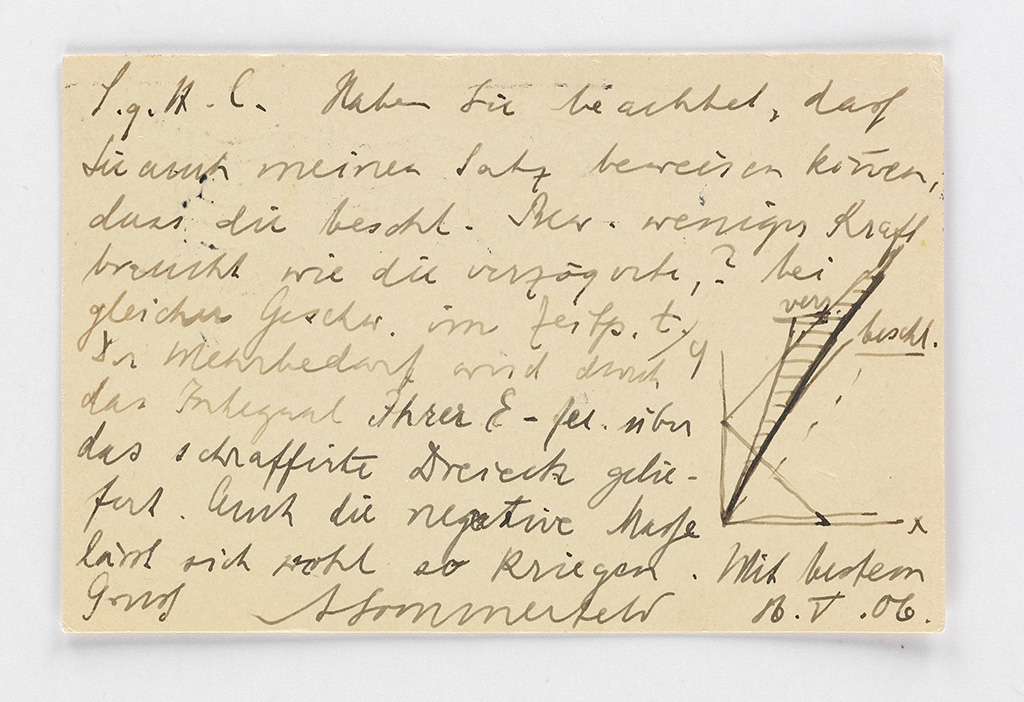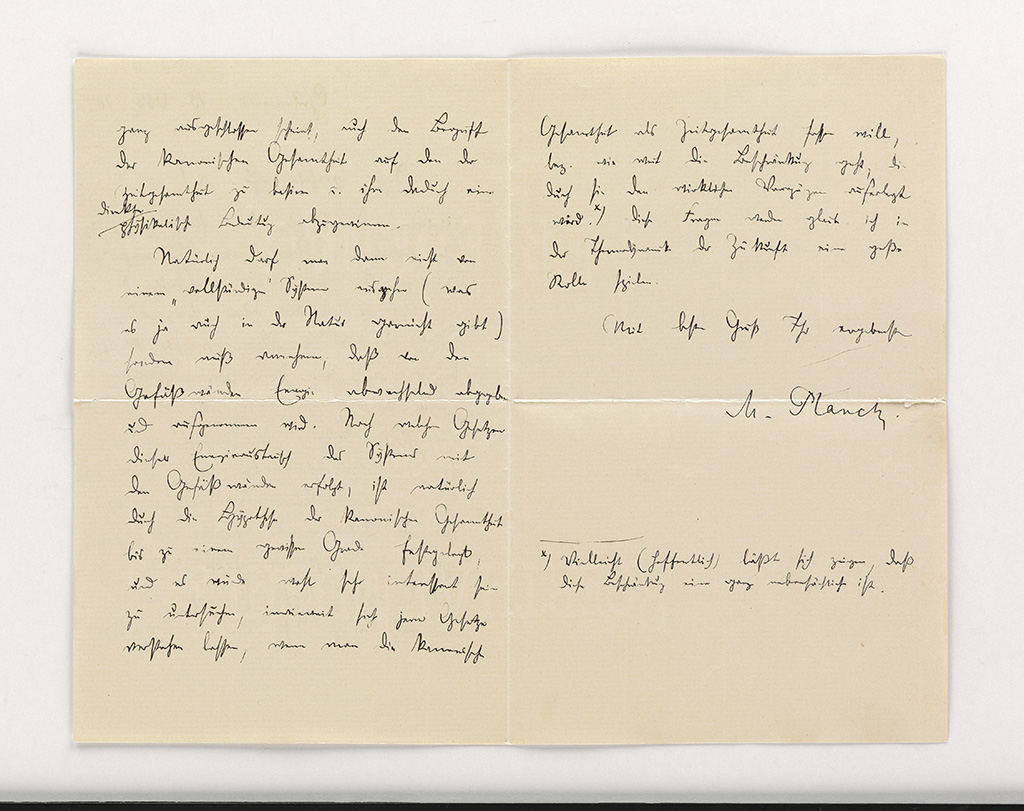Sale 2333 - Lot 81
Price Realized: $ 25,000
Price Realized: $ 32,500
?Final Price Realized includes Buyer’s Premium added to Hammer Price
Estimate: $ 10,000 - $ 15,000
GÖTTINGEN PHYSICISTS AND OTHERS (SCIENTISTS.) Group of 17 letters from physicists and other scientists to Paul Hertz, in German, on thermodynamics, nature of electrons, black-body radiation, relativity and other topics, including 10 ALsS, 5 Autograph Postcards Signed, and two TLsS, some with holograph diagrams or equations. Together 36 pages, mostly 8vo; condition generally good. Vp, 1906-52
Additional Details
Arnold Sommerfeld. 16 May 1906: "Have you noted that you can use my proposition to prove that the accelerated motion requires less force than the delayed motion? At the same speed at the point in time t. The increased demand is supplied by the integral . . . [small holograph diagram] the hatched triangle. The negative quantity can probably be obtained in this way as well."
Paul Ehrenfest (2). [Circa October 1906]: The undersigned is a [small holograph drawing of a dog]! . . . [H]ow would it be if we had you here in Göttingen--actually, that would be very nice. For there are probably not many people with whom we could feel at home. . . . Please, for God's sake, let me forget that I got myself into electrons. Indeed, I understand absolutely nothing of this. . . . I am still just calculating everything for one moment . . . and even if that results in an uncertainty, it still doesn't mean anything . . . . And perhaps no differential quotient exists. In short--to hell with it. It's beyond me. . ." 17 September 1910: ". . . Tell me . . . why you consider our critiques of Gibbs' irreversibility calculation inconclusive. His calculation is totally wrong--it is a gross quaternio terminorum. . . ." With a postscript: "Please send your treatise on the string galvanometer!"
Max von Laue (4). 25 October 1906: ". . . [Y]ou thought that a deviation from Wien's displacement law could not be used for construction of the perpetuum mobile II . . . [T]he statement that black-body radiation cannot be compensatively changed into nonblack cannot be based on the impossibility of this machine. I have been studying Planck's book . . . . But it can be easily refuted in the following way . . . . Result: The initial state is restored, and warmth from the colder body has transferred to the warmer one, so the perpetuum mobile II would be finished" 10 May 1940 1 December 1952, TLS 30 December 1952, TLS.
Hendrik Lorentz (6). 26 June 1907 13 March 1908: ". . . From your formula . . . I derive the following value for the conductivity of the chlorine . . . in electromagnetic CGS units . . . . The formula . . . is not valid if one assumes that the water molecules take up a considerable part of the space and that the ions ricochet off them. . . . [T]he value . . . just calculated could be regarded as the mean path for the water molecules themselves, but the free path length for ions found among the molecules can differ from it significantly and [would] probably also be smaller. I would especially like to point out that the influence that the electrical 'polarization' of the water particles has on the movement of the ions will perhaps reduce the path length even more. . . . [I]t is quite possible that the negative electrons in a metal have a much greater mobility than the ions in the solution, that they are merely held back, so to speak, from the nuclei of the atoms . . ." 19 December 1910 6 January 1911 3 April 1911: ". . . I lecture six hours a week, but for you, only two lectures would come into consideration: one . . . on the concept of entropy and static mechanics, the other . . . on matters of electrical theory in connection with the relativity principle. . ." 18 April 1911: ". . . Perhaps it would be wise not to limit ourselves to a single [topic] right away . . . . I would like to suggest . . . the first (application of thermodynamics to chemical phenomena), fourth (ion movements), and fifth (rigidity, molecular forces). . ."
Willem Einthoven: 15 January 1910: ". . . I intend to create a few more curves with as little air friction as possible and hope then to be able to tell you more . . . ."
Max Planck. 15 October 1910: ". . . What pleased me . . . is your strong emphasis on the concept of time ensemble. I share your belief that this is the only satisfactory starting point for the mechanical definition of thermodynamic magnitudes. . . . [I]t does not seem to me totally out of the question to base the concept of canonical ensemble on that of the time ensemble and to gain thereby a direct physical definition. Naturally one must not then proceed from a 'complete' system (which indeed does not even exist in nature) but must assume that energy is alternately released and absorbed from the container walls. By which laws this energy exchange of the system occurs is naturally determined . . . by the hypothesis of canonical ensemble . . . . These issues, I believe, will play a major role in the thermodynamics of the future."
Albert Einstein (2). 18 May 1922: "I have known Mr. P. Hertz for many years . . . . He is undoubtedly among the most astute theoretical physicists in Germany . . ." 27 March 1940: "With utmost regret I learned of the bitter loss you have suffered. . . . Your husband's work often impressed me with its enlightening clarity, and I don't believe it was ever accorded proper recognition. This is probably related to the fact that in this period, which is transitional in regard to science as well, the quest for new forms is deemed more urgent than the pursuit of clarity. . . . ."
Paul Ehrenfest (2). [Circa October 1906]: The undersigned is a [small holograph drawing of a dog]! . . . [H]ow would it be if we had you here in Göttingen--actually, that would be very nice. For there are probably not many people with whom we could feel at home. . . . Please, for God's sake, let me forget that I got myself into electrons. Indeed, I understand absolutely nothing of this. . . . I am still just calculating everything for one moment . . . and even if that results in an uncertainty, it still doesn't mean anything . . . . And perhaps no differential quotient exists. In short--to hell with it. It's beyond me. . ." 17 September 1910: ". . . Tell me . . . why you consider our critiques of Gibbs' irreversibility calculation inconclusive. His calculation is totally wrong--it is a gross quaternio terminorum. . . ." With a postscript: "Please send your treatise on the string galvanometer!"
Max von Laue (4). 25 October 1906: ". . . [Y]ou thought that a deviation from Wien's displacement law could not be used for construction of the perpetuum mobile II . . . [T]he statement that black-body radiation cannot be compensatively changed into nonblack cannot be based on the impossibility of this machine. I have been studying Planck's book . . . . But it can be easily refuted in the following way . . . . Result: The initial state is restored, and warmth from the colder body has transferred to the warmer one, so the perpetuum mobile II would be finished" 10 May 1940 1 December 1952, TLS 30 December 1952, TLS.
Hendrik Lorentz (6). 26 June 1907 13 March 1908: ". . . From your formula . . . I derive the following value for the conductivity of the chlorine . . . in electromagnetic CGS units . . . . The formula . . . is not valid if one assumes that the water molecules take up a considerable part of the space and that the ions ricochet off them. . . . [T]he value . . . just calculated could be regarded as the mean path for the water molecules themselves, but the free path length for ions found among the molecules can differ from it significantly and [would] probably also be smaller. I would especially like to point out that the influence that the electrical 'polarization' of the water particles has on the movement of the ions will perhaps reduce the path length even more. . . . [I]t is quite possible that the negative electrons in a metal have a much greater mobility than the ions in the solution, that they are merely held back, so to speak, from the nuclei of the atoms . . ." 19 December 1910 6 January 1911 3 April 1911: ". . . I lecture six hours a week, but for you, only two lectures would come into consideration: one . . . on the concept of entropy and static mechanics, the other . . . on matters of electrical theory in connection with the relativity principle. . ." 18 April 1911: ". . . Perhaps it would be wise not to limit ourselves to a single [topic] right away . . . . I would like to suggest . . . the first (application of thermodynamics to chemical phenomena), fourth (ion movements), and fifth (rigidity, molecular forces). . ."
Willem Einthoven: 15 January 1910: ". . . I intend to create a few more curves with as little air friction as possible and hope then to be able to tell you more . . . ."
Max Planck. 15 October 1910: ". . . What pleased me . . . is your strong emphasis on the concept of time ensemble. I share your belief that this is the only satisfactory starting point for the mechanical definition of thermodynamic magnitudes. . . . [I]t does not seem to me totally out of the question to base the concept of canonical ensemble on that of the time ensemble and to gain thereby a direct physical definition. Naturally one must not then proceed from a 'complete' system (which indeed does not even exist in nature) but must assume that energy is alternately released and absorbed from the container walls. By which laws this energy exchange of the system occurs is naturally determined . . . by the hypothesis of canonical ensemble . . . . These issues, I believe, will play a major role in the thermodynamics of the future."
Albert Einstein (2). 18 May 1922: "I have known Mr. P. Hertz for many years . . . . He is undoubtedly among the most astute theoretical physicists in Germany . . ." 27 March 1940: "With utmost regret I learned of the bitter loss you have suffered. . . . Your husband's work often impressed me with its enlightening clarity, and I don't believe it was ever accorded proper recognition. This is probably related to the fact that in this period, which is transitional in regard to science as well, the quest for new forms is deemed more urgent than the pursuit of clarity. . . . ."
Exhibition Hours
Exhibition Hours
Aliquam vulputate ornare congue. Vestibulum maximus, libero in placerat faucibus, risus nisl molestie massa, ut maximus metus lectus vel lorem.








